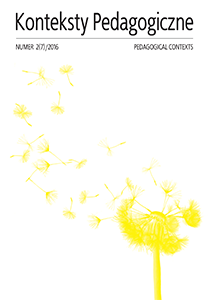Abstract
The present study aims to analyse possible reasons of failure among primary school children. The author presents a comparative study of two types of schools. She presents a school which does not motivate its students to learn as well as the one that promotes curiosity and desire to learn among its learners.
References
Ames C.A., Motivation: What teachers need to know, “Teachers College Record” 1990, vol. 91, no. 3.
Eccles S., Wigfield A., Schiefele U., Motivation to succeed, [in:] Handbook of Child Psychology, vol. 3, ed. N. Eisenberg, 5th ed., New York 1998
Holt J., How Children Fail: Classics in Child Development, New York 1982.
Krashen S.D., Second Language Acquisition and Second Language Learning, New York 1988.
Seligman M.E., Reivich K., Jaycox L., Gillham J., The optimistic child, New York 1995.
Stages of Acceptance of a Learning Disability: The Impact of Labeling,“Learning Disabil-ity Quarterly” 2000, vol. 2, no. 1.
Tollefson N., Classroom applications of cognitive theories of motivation, “Educational Psychology Review” 2000, vol. 12, no. 1.
Yough P., How children succeed: grit, curiosity, and the hidden power of character, New York 2012.
In accordance with the recommendation of the Ministry of Science and Higher Education, which aims to counteract the practice of “ghostwriting” and “guest authorship,” all authors submitting their text for publication should attach an author’s statement which declares the contribution of each of the authors to the article. The printed and signed statement should be delivered by mail or other means to editor-in-chief Joanna Skibska or sent in the form of a scan to the following e-mail address: redakcja@kontekstypedagogczne.pl. The authors will not receive remuneration for publishing their papers. The editors reserve the right to make minor editorial changes to the articles which will not affect the substance of the article. We encourage all authors to prepare their articles in accordance with the guidelines for manuscript preparation. Download pdf file.
Authors transfer all copyrights and grant the journal the right of first publication with the work simultaneously licensed under a Creative Commons Attribution License that allows others to share the work with acknowledgement of the work's authorship and initial publication in this journal. All authors agree to the publishing of their email addresses, affiliations and short bio statements with their articles during the submission process.

